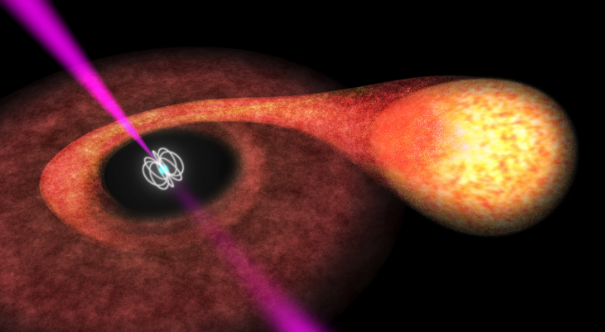
Credit: ESA
The X-ray pulsars were discovered in the 70s and are among the most luminous objects in the X-ray sky. They are binary systems that consist of a magnetized neutron star in orbit with a normal stellar companion. The magnetic field of the neutron star is over a trillion times stronger than the strength of the magnetic field at the surface of the Earth. X-ray pulsars are strong X-ray emitters that display periodic variations in their X-ray intensity. These variations range from as little as a fraction of a second to as much as several minutes.
Based on the knowledge we have obtained the last forty years from their discovery, the physical mechanism that generates the X-rays is the following: First, gas is accreted from the stellar companion and is trapped by the neutron star’s magnetic field. There are various ways that this gas supply can take place, depending on the size and shape of the neutron star. In some cases the stellar companion is a very massive young star (OB) that emits a stellar wind from its surface. The neutron star captures gas that flows nearby. In other cases, the stellar companion and the neutron star orbit each other so closely that the gravitational field of the neutron star pull’s material from the its companion (Roche lobe overflow). Finally, there are cases that the star rotates so rapidly that creates a disk of gas around its equator. In these cases the orbit of the neutron star with its companion is large and elliptical. When the neutron star passes nearby or through this disk of gas, it captures material.
The gas the neutron star traps with its magnetic field is funneled to its magnetic poles. There, the infalling gas reaches speeds up to half the speed of light before it impacts the surface of the neutron star. The energy that is released makes these hotspots ten thousand times more luminous than our Sun. The temperatures reach millions of degrees and thus the hotspots emit mostly in X-rays. As the neutron star rotates, pulses of X-rays are observed.
X-ray pulsars nowadays are observed using X-ray telescopes that orbit the Earth. The first X-ray pulsar to be discovered was Centaurus X-3 in 1971 with the Uhuru X-ray satellite.
Source: Wikipedia
Publication: Caballero and Wilms (2012)
